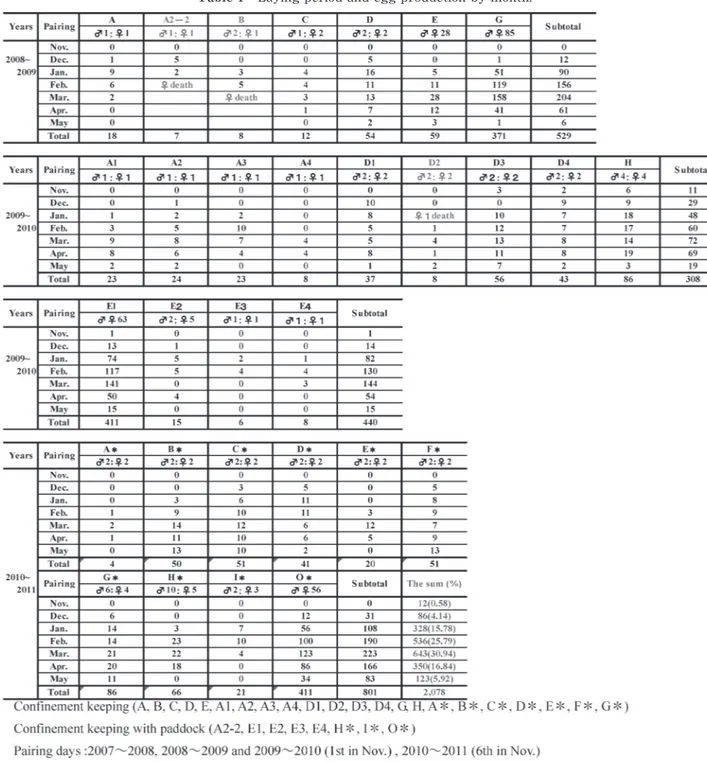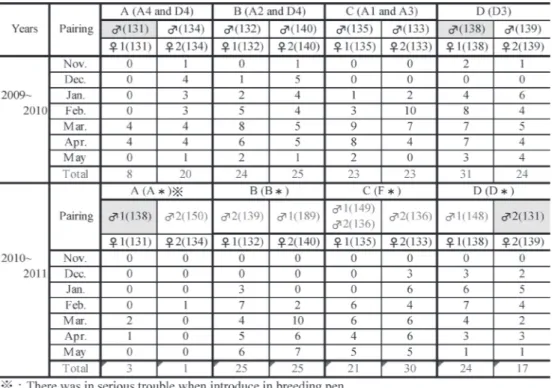Effects of Pairing on Egg Laying in the Emu
By
Michinari Yokohama*
†, Hiroyuki Jinushi*, Satoshi Imai* and Kei Ikeya*
(Received July 3, 2013/Accepted December 6, 2013)
Summary:The emu is a ratite with marked environmental adaptability, bred in Abashiri City, Hokkaido mainly for oil (functional material) production. However, laying, fertility, and hatchability should be improved for mass breeding. Thus, in the present study, we investigated the relationship between pairing and laying to improve egg production. The laying period was seven months between November and May of the following year. Egg production was highest in February and March at 25.79 and 30.94%, respectively. The relationship between pairing and laying demonstrated that egg production in breeding groups of equal female-to-male ratios (18.50 eggs per female) was significantly higher than those of population breeding groups and breeding groups with unequal female-to-male ratios (6.55 and 9.51 eggs per female, respectively) (p<0.001). The female-to-male ratio was altered in pairing, markedly decreasing the egg production from 20 to 1 the following year. For example, two females died as a result of an accident during transfer to a different pen, conducted to prevent pairing with the same male, while one female mated with two different males. Thus, some females continued to mate with the previous males, while the others mated with different males after laying. Fertility was 89.64 and 86.14% and hatchability was 67.34 and 64.64% in 2009-2010 and 2010-2011, respectively.
Key words:emu, pairing, compatibility, egg production
Introduction
The emu (Dromaius novaehollandiae) is the second largest ratite after the ostrich and native to Australia. Wild emus can be solitary or live in groups1). In the
Southern Hemisphere, emus breed between October and May in short sunshine duration. In the Northern Hemi- sphere, in the United States, they lay eggs in winter be- tween September and April. In Hokkaido, emus breed around October and generally lay eggs between December and April. A female emu lays one egg at 3-5-day inter- vals until laying a total of 10 eggs. In the wild, male emus brood the eggs. They fast for about two months until hatching, and lose 20 kg in weight. Emus can be monogamous or polyandrous1).
Emu farming started in western Australia in 1970. Emu farming is attracting attention as a new industry, because emu oil is effective for the treatment of atopic dermatitis, burns and wounds, and bruises. Currently, emus are farmed in the United States and China, as well as in Australia1).
In Hokkaido, emus were introduced in the 1980s.
Emus can be bred relatively easily under diverse weather conditions even in Hokkaido, with its consider- able temperature range. Emus are attracting attention as an oil-producing animal. However, in Japan, they lay only a small number of eggs (about 10 eggs). Thus, in the present study, to increase laying for mass breeding, we investigated the effects of pairing during breeding on laying.
Materials and Methods
Pairing
The effects of pairing on laying were investigated under the natural light condition between 2007 and 2008 and between 2010 and 2011. Emus were bred in breeding groups of equal female-to-male ratios (8 pairs in 1 : 1 area ; 10 pairs in 2 : 2 area ; 1 pair in 4 : 4 area) and unequal female-to-male ratios (2 pairs in 2 : 1 area ; 1 pair each in 5 : 2, 4 : 6, 5 : 10, and 3 : 2 areas) and population breeding groups (6 groups of 28, 50, 56, 63, 85, and 100 emus). We used adult emus aged 4-10 years. Laying dates and egg production were recorded for one pair each of the breeding groups of the female-to-male ratios of 1 : 1 and 2 : 1 and
*
†
Department of Bioproduction, Faculty of Bioindustry, Tokyo University of Agriculture Corresponding author (E-mail : m-yokoha@bioindustry.nodai.ac.jp)
four test areas of population breeding with 50 and 100 emus between 2007 and 2008 to be statistically analyzed. Fisher’s least significant difference test was used for statistical analysis.
Pens of each test area were assembled using D-type agricultural fencing (Fig. 1). Emus were paired on November 1 in 2007-2010 and on November 6 in 2010-2011. The emus of each test area were identified by markings on their backs.
Records of egg-laying time, egg production, and laying dates
Eggs were collected at 30-minute intervals between 15 : 00 and 18 : 00, when emus lay more eggs, in order to prevent low-temperature injury. Eggs laid out of this time zone were used for food. The collected eggs were identified with test area symbols and laying dates. Incubation
The identified eggs were incubated in an incubator, SHOWA FURANKI, TYPE : P3 (capacity : about 14 eggs), at 36.3℃, 32% relative humidity, and 12 egg rotations/ day. Eggs on day 45 of incubation were transferred into an incubator (Ostrich Hatcher TYPE : SH10, SHOWA FURANKI, capacity : about 96 eggs) at 36.3℃ and 32% relative humidity.
Determination of fertilized eggs
Fertilized eggs were determined depending on embry- onic development using an infrared projector (WIRELESS TSUKAMOTO CO. LTD, SM-56-850) and a ultrasensitive monochrome CCD camera monitor (WAT-902H2, Watec) on day 7 after the start of incubation. Those with em- bryonic development (black shadow on the monitor)
were identified as fertilized eggs, while those without embryonic development were identified as unfertilized eggs (unpublished data).
Results and Discussion
Pairing and laying periods and laying
Emus were paired between 2008 and 2011 in the three test areas of equal and unequal female-to-male ratios and population breeding (Table 1). Laying was observed between November, when the pairing was started, and May of the following year. Laying peaked in February and March at 25.79 and 30.94%, respectively. Emus were paired between 2008 and 2011 in the three test areas of equal and unequal female-to-male ratios and population breeding (Table 1). Laying was observed between November, when the pairing was started, and May of the following year. Laying peaked in February and March at 25.79 and 30.94%, respectively.
Egg production per female varied with individuals : 2-28 eggs for the groups of equal female-to-male ratios, 3-22.2 eggs for the groups of unequal female-to-male ratios, and 4.2-13.26 eggs for the population breeding groups. Average egg production per female was signifi- cantly different between the groups with equal female-to-male ratios (18.5 eggs) and the other two groups (9.51 eggs for the groups of unequal female-to-male ratios ; 6.55 for the group of population breeding) (p<0.001) (Table 2). Emu farms in Australia reported a high laying rate at the female-to-male ratio of 2 : 12). However, S
enthikuman
and Jagatheeas (2012) reported egg production of 28.06±
2.56 eggs in the third-term breeding by pairing at a female-to-male ratio of 1 : 1. They suggested that laying might be improved by breeding at an equal female-to-male ratio. This is consistent with our results. Thus, breeding at an equal female-to-male ratio is recommended to select breeding emus with high-level egg production. Of three pairs (A2-2, B, and D2), females of A2-2 died of old age at 18 years, and produced 18 eggs in the pre- vious year between 2007 and 2008, and produced about 20 eggs every year for about 14 years. The remaining females of B and D2 died as a result of an accident (Table 1). No conspicuous trauma was noted. Thus, they may have suffocated to death by getting their necks stuck in a wire mesh fence during transfer to a different pen, conducted to prevent pairing after mating and laying, rather than through fighting. Emus breed in a monogynous or polygynous (polyandrous) form3). These
accidental deaths may have involved polygamous indi- viduals. Specifically, a female seeks a different male after mating with the previous one and laying. Like the No. 135 female, some females mated with two different males. They may have changed males after laying as described Fig. 1 Individual identification in each pen
above. The other females mated with the previous males. In the wild, when a male starts to brood, a female leaves the male to mate with a different one3, 4).
Subsequently, the effects of pairing between 2009 and 2010 and between 2010 and 2011 on laying were exa-
mined (Table 3). As a result, the laying of the No. 134 fe- male was markedly decreased from 20 to 1 the following year. This may have resulted from female-to-male incompatibility during pairing. Like the No. 131 female, some females showed decreased laying even after Table 1 Laying period and egg production by month.
changing males. In contrast, the No. 133 female showed increased egg production from 23 to 30 after changing males. The egg production may have been influenced by laying performance and female-to-male compatibility.
Pairing, fertility, and hatchability
Improved hatchability is the most critical point for emu breeding. Thus, the effects of pairing on egg pro- duction and hatchability were investigated (Table 4). Of Table 3 Comparison of egg production in each female emu when changed pairing partner.
the pairings with a large number of cases, the average fertility between 2009 and 2010 was as high as 89.64%, while the hatchability was low, except for the A1 and D1 pairings (86.67 and 81.82%, respectively), and the average hatchability was 67.34%. Between 2010 and 2011, the average fertility was 86.14%, while the hatchability was low, except for the F pairing (81.25%), and the average hatchability was 64.64%. Boopathi et al. (2012) reported
100% fertility and 63.6% hatchability. This hatchability was almost the same as our results.
In both years, the fertility varied from 33.33 to 100%, while the hatchability varied from 14.29 to 86.67%. The cause of this is unknown. Besides genetic characteristics, the environmental conditions of long-term incubation be- tween January and July and storage time after incuba- tion may be involved. During this period, the period of fertilized egg collection was limited due to very cold weather in Abashiri City. The improved egg collection time and intervals significantly increased the fertility from 40-50 to 80%.
Acknowledgment
We thank Mr. Fujio Nakayama, a representative of
OKHOTSK EMU PASTURE, for providing test materials to conduct this investigation.
References
1) Inui K, Suzuki T, Takahashi Y, Tsuda K, Nagasawa M,
Nagashima T, Nakayama T, Schmidt M, Mikami A,
Yokohama M, Watanabe T (2009) New book for keeping
emu. Tokyo University of Agriculture Press, pp. 1-125. 2) Minnaar M (1998) The Emu Farmer’s Handbook-Volume
2. Nyoni Publishing Co. (USA), pp. 1-319.
3) Patodkar V R, Rahane S D, Shejal M A, Belhakar D R
(2009) Behavior of emu bird (Dromaius novaehollanfiae), Vet. World. 2 : 439-440.
4) Senthikuman P, Richard Jagatheesan P N (2012) Produc-
tion performance of emu (Dromaius novaehollandiae) under field conditions. Indian Vet. J. 89 : 97-99.
5) Boopathi V, Sivakumar T, Tensingh Gnannaraj O (2012)
Quality and hatching performance of emu eggs. Indian Vet. J. 89 : 87-88.

